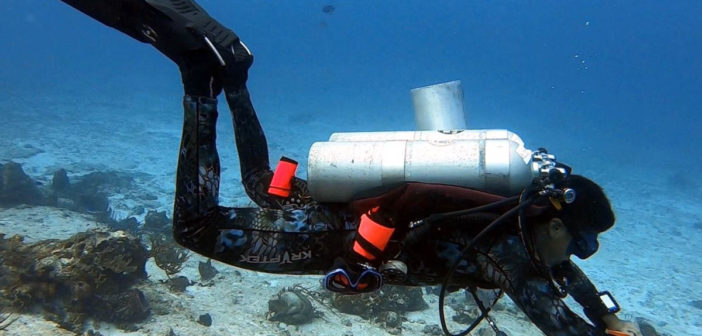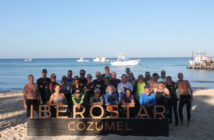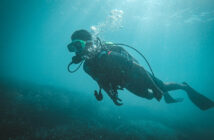Before I was a diver, I was an avid snorkeller that fantasised deeply about the idea of being able to go scuba diving. The concept of being able to go to depth and stay there looking at wildlife without having to return to the surface for air was mind blowing. When I first started seeing modern day scuba divers, I was extremely confused by the fact that they all seemed to be missing a cylinder. Every diver I’d ever seen in films, books or had as action figures growing up all had two cylinders on their back. Sean Connery in an underwater knife fight, or Gordon Tracy swimming around thunderbird four were some of the favourites. That was the definition of a scuba diver to me, and seeing them with just the one cylinder didn’t make sense to my untrained eye. Of course, the reasoning behind such vintage divers always having more than one cylinder is clear to me now, simply being that in the past, the technology available did not allow for ample gas to be carried in a single cylinder that many recreational divers use today. Naturally though, something about the idea of having that extra gas and being able to carry out deeper dives for a longer time really appealed to me throughout my recreational training. I saw plenty of it diving at inland sites in the UK where it is commonplace to see both recreational and technical divers using twinsets for the added redundancy. I couldn’t shake the idea of wanting to learn how to use a twinset, so after completing my instructor training in Cozumel, I decided to venture into a technical course.
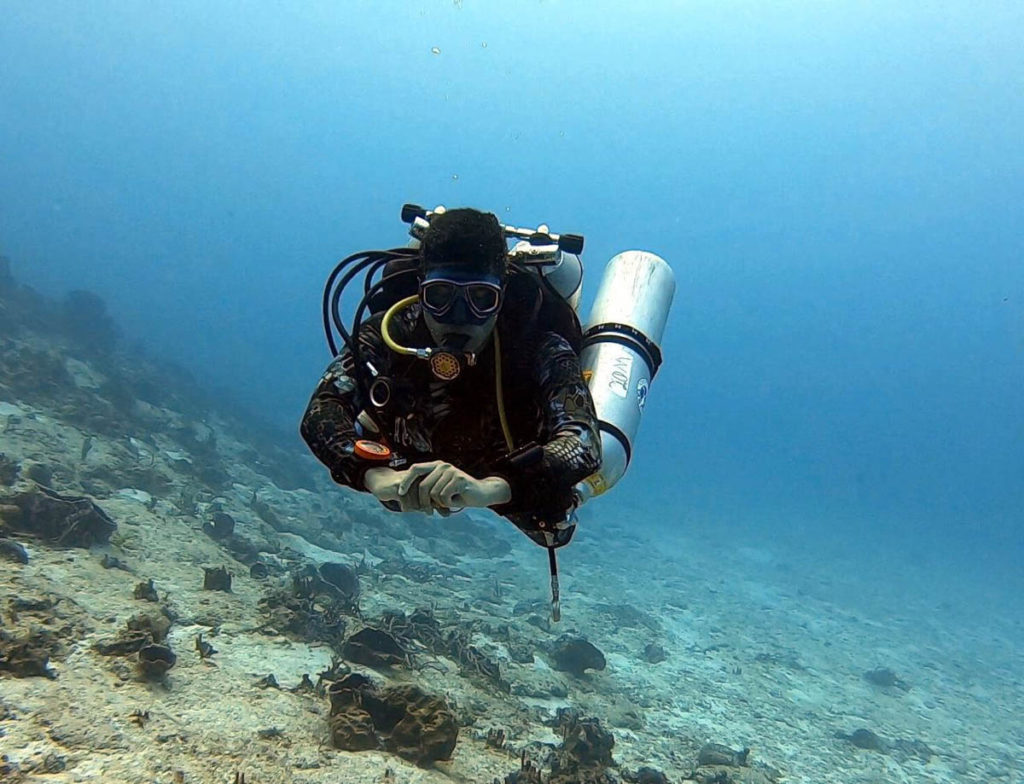
I had done my research before deciding that going with an instructor that I clicked with was going to be more important than the agency that I learned with. Similar to recreational diving, when digging through the vast troves of internet forums you can find a huge amount of agency bashing and explanations as to why one system is better than the others. However, the opinion of many top instructors within tech (much like recreational), is that it comes down to who taught you and how you were taught more than the syllabus or agency. The reality in the technical world is also that many of the agencies have a very similar syllabus, especially in the initial courses. Some such as GUE stipulate more on universal gear configurations than others, but across PADI, TDI, RAID and others, there are far more similarities than differences. Given that I had just completed my IDC at Cozumel Dive School and that the owner Kenneth Strömberg is a PADI TecRec instructor that I know and trust, it made sense to venture into tech with a familiar face guiding me. Cozumel as a location also lends itself well to the depths needed to complete the PADI Tec40/45/50 progression, as the numbers imply, these are the maximum depth limits for each component of the programme. The shallow reefs are bordered by walls which drop off steeply to around 500m, plenty of depth for technical deep courses. The typical drift conditions off Cozumel also mean that mastering midwater skills is unavoidable.
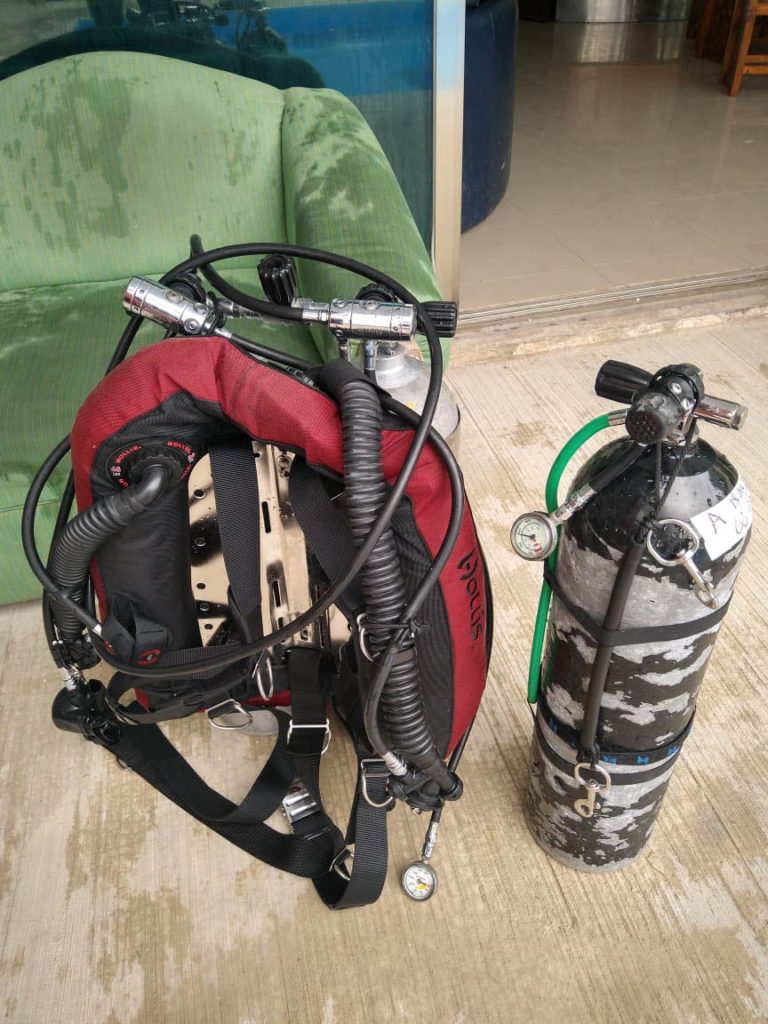
After working through hundreds of pages of theory and the accompanying knowledge reviews, the time came to finally get my hands on the gear I would be using and take it for an initial pool dive. The difference in kit is initially quite staggering. While I was familiar with the backplate and wing setup due to its popularity in recreational diving, a manifolded twinset with accompanying redundant buoyancy bladder, longhose and necklace regulators were alien territory. Just setting the gear up is a bit of a procedure, notably that the routing of hoses needs to follow a standard configuration so that the most essential hoses (to regulators) are not obstructed in any way by the less essential inflation hoses. It takes a few times of putting the gear together and routing the hoses before you get an idea of how the hoses should look when it is done correctly. Due to the fact you have two posts to consider with a twinset, it can appear that there are far more hoses to contend with. The reality is actually that there aren’t, the only notable additional hose is a second low pressure hose which connects to the redundant buoyancy system (assuming your wing has a second bladder). Once the gear is set up, it is then a case of donning the rig and again routing hoses around your front side, paying particular attention to how the long hose and SPG are stowed such that they do not create snag hazards. With this done, it was time to step into the pool.
The first thing that really struck me was how much more encumbering the twinset felt. Due to the wing configuration, it was easy to remain level, but turning on the spot and propulsion was much slower. After a few laps round the pool to get used to the kit, it was time to start practicing the new safety skills which come with the manifolded twinset, via safety drills (S-Drills). The shutdown S-Drills were the hardest of these to master. Shutdowns involve being able to troubleshoot a catastrophic failure of part of your first stage or manifold by isolating it and rerouting air in such a way that a safe ascent can then be made. The key is always having a regulator to breathe from for your depth, and where possible preventing a rapid loss of your remaining gas. This is a real test of dexterity as it involves being able to operate all three valves behind your head, the pillar valves to the cylinders on either side and the manifold valve, directly behind a diver’s head. This in itself isn’t too bad if you are relatively flexible, what makes it daunting at first is that you will be dealing with a simulated free flow, either on one of your regulators or behind your head at the first stage / manifold. My first major wakeup call was when I first had my regulator in my mouth purged at full whack, with no let up from Ken to simulate it being a worst-case free flow. I tried to reach behind my head and shut off the regulator, but I found the air was coming so fast that it was difficult to breathe. I didn’t seem to be able to get half the regulator out my mouth as you would when breathing a free flow typically, due to not having a free hand. I was able to breathe but truly felt like I couldn’t because the sips of air I could take were so shallow. My thought process was now no longer on shutting down the free-flowing regulator, but on being able to take a satisfying breathe of air. For the first time in a few years of diving, I panicked and pushed myself to the surface to do so. A few moments later, Ken bobbed up to ask how I was doing and what had gone wrong. Having explained my difficulty breathing, Ken pointed out that I had another perfectly functional regulator a few inches below the one he had been purging. Why hadn’t I just swapped to that? I honestly don’t know, but that’s what I did every time that drill re appeared, and it made the process much easier. The process of learning the basics in tech had many more challenges like this, where there was often a much better way of solving a problem, but the first time it was presented there was a lot of fumbling because it was new territory. All drills are made more complicated by the fact that you should be able to complete them one handed, and without your depth deviating more than half a meter or so. One hand is extended in front of you watching your dive computers depth read out, while the other works to solve the problem.
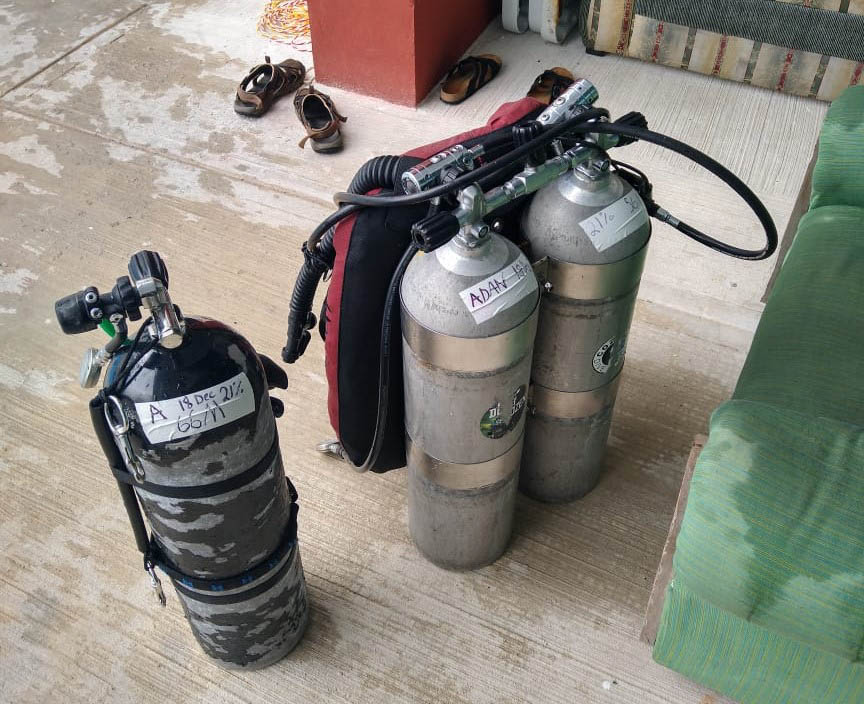
Once out of the pool and into the sea, the training actually became a pretty enjoyable process. We spent the majority of the first days at a shallow site in 10m or so, practice mock deco stops, retrieving cylinders from shot lines, swapping them between ourselves on the move and calculating our surface air consumption (SAC) rates. All of this with the occasional unexpected gas supply malfunction or losing a mask, simulated by Ken. One of the most interesting things about tech is that every dive is planned meticulously, using information that you have determined on previous dives (such as your SAC rate). During the training process we probably spent about as much time, if not more, planning the deeper dives we would be undertaking as actually carrying them out. Some people might find this idea tedious; I would suggest that these people would not be suited to trying tech. The great news is that computer software such as MultiDeco can greatly ease dive planning. Each dive also has an objective, which is something I personally really enjoy. That can be as simple as reach 40m and spend 10 minutes there, or more complicated such as penetrate a wreck or photograph a fish that typically hangs out deeper than recreational diving permits. Knowing that you are setting out to achieve something on your dive means that you get a sense of accomplishment when everything goes to plan. The principle of every tech dive including the qualifying dives in each of the Tec40/45/50 sections is that you should come back unharmed with as much air as you planned to come back with, or more. You should also not exceed the dives planned runtime, which is the total time from descending to breaking the surface on ascent. The depths, time spent at depths, time spent ascending, time spent deploying SMBs, time spent gas switching… you name it, if something that has to be done takes time, it is factored into the plan. An overrun on the plan means something didn’t happen fast enough, or something was delayed. On the other hand, coming back up with too little runtime may mean you have accidentally omitted some decompression, which could be a fatal error. Hence when tech diving, the plan is adhered to and constantly cross-checked with your team members. Unlike recreational diving, you do not simply follow your computer, it is there as a depth gauge and backup system. If a team mate misreads the plan and begins to deviate from it, then another team member should step in and stop them. Between the additional gas carried, constant cross checking and backup options, tech diving is actually incredibly safe despite some misconceptions that it is much more dangerous than recreational diving.
The rewards for working through technical training, even the entry level courses such as PADI TecRec, are many. It gives a diver a much greater appreciation of decompression and how it should be correctly managed, both from a diver’s skill level with excellent buoyancy control and through the use of high nitrox blends (up to 100% oxygen for shallow decompression). The use of these high blend gases also helps to reinforce a diver’s knowledge of maximum operating depths (MODs) at both 1.4 and 1.6 partial pressure of oxygen. The use of 1.6 ppO2 is another new prospect in tech, this new ppO2 limit becomes available for gases that will only be used during the “inactive” decompression phase of a dive. This allows for these gases to be used at a slightly greater MOD, hence expanding the depth range you can decompress with them from. The new motor skills and problem-solving abilities which come with shutdown procedures and other S-Drills mean that when you are recreational diving, you should have a much easier time solving any problems that arise. Not to mention, it will give you a renewed appreciation for how free you are when single cylinder diving compared to all the additional gear carried for technical dives. Mastering your buoyancy for decompression stops during tech will of course also translate to better buoyancy control in all aspects of your diving. Being able to send up a DSMB without changing depth is a skill that even many instructors can’t do perfectly, but you should be doing this almost every time during your tech courses. The streamlining and arrangement of gear to minimise entanglement hazards and confusion is also a skill that is useful across the board, not just in the tech environment.
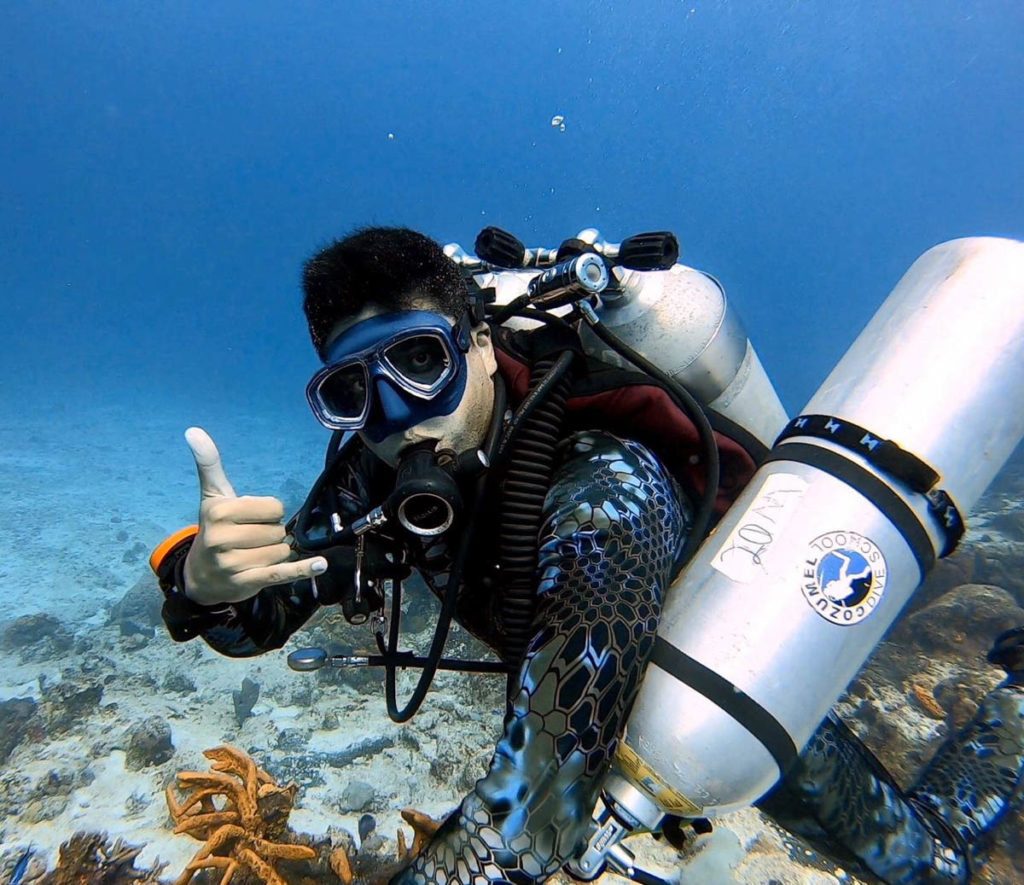
My own tech journey has only just begun, but it has been some of the most fun I have had diving to date. Frustratingly, COVID-19 cut short my Tec50 course, I am still two dives away from earning the certification. Currently, it is the thing I am looking forward to resuming the most. For any divers that perhaps like me had been eyeing the technical scene from a distance and wondered about trying it, I would definitely suggest you go ahead. As I mentioned earlier, going with a location, centre and instructor you get along with will give you a better experience than simply picking via a preference for an agency. A good technical instructor should have an understanding of how other organisations outside of the one they teach also do things, and share a broader range of knowledge than simply their own syllabus. Becoming a technical instructor requires hundreds of hours clocked up on a range of technical dives, so assuming they are officially certified, they should have a wide understanding that they can share with you. Technical diving and the science which it hinges on are the cutting edge of what humans can achieve without submersibles in terms of underwater exploration. Now why wouldn’t you want to try being a part of that?




